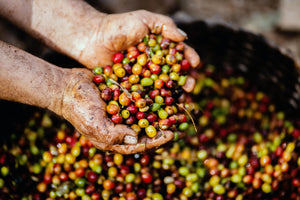There are many species of coffee in the world, but the two most popular varieties are arabica and robusta beans. Together, they dominate most of the world’s coffee market – but what’s the difference between them?
In today’s article, we break down the differences between arabica and robusta beans, including where they grow, how they taste, and which one contains more caffeine, to try and answer the ultimate question – which one is better?
Arabica vs Robusta: What’s the Difference?
Let’s start with a bit of background to these two varieties of coffee – because although they are related, there are quite a few differences between them.
Arabica Coffee Plant
Representing roughly 60% of the coffee consumed across the globe, Arabica is the most popular coffee bean in the world. The plant originates from Ethiopia, but today it’s planted in many countries, including Peru, Brazil, and Colombia.
The Arabica plant is quite sensitive and requires specific growing conditions to thrive. It likes sub-tropical climates and high altitudes, and needs both rich soil and a good amount of water. Because it lacks natural defenses against pests, it also needs a lot of care to grow well.

Still, the arabica bean is well-loved for its rich, complex flavor and is considered premium-grade coffee.
Robusta Coffee Plant
The Robusta plant originates from Africa as well, but is known for its bitter, strong flavor profile. The plant itself is more pest resistant than the arabica plant, and can grow well in a variety of environments. Still, it prefers low-altitude farms and can weather a lot of sunlight – and since sunlight makes the plant grow faster, this makes it a popular choice for large, commercial plantations.
Making up almost 40% of the coffee consumed across the globe, Robusta is the second most popular coffee type in the world, and is common in instant coffee, commercial coffees, and often used as filler beans in coffee blends. It’s generally considered second-grade coffee.
Now, let’s compare some of the most characteristic differences between robusta and arabica.
Flavor of Arabica vs Robusta
Flavor in coffee depends on more than just the type of bean – both robusta and arabica beans can range a lot in taste depending on where they’re grown, how they’re roasted, and more.

But Arabica beans are generally considered to be more refined in taste, with a rich and well-balanced flavor profile. This is partly because of the high amount of acids, and partly because Arabica contains about 60% more sugar and lipids than robusta does, which helps to bring out more aromatic compounds when the beans roast. The sugar also balances out the more bitter flavors that are natural to coffee.
Robusta beans, on the other hand, have a bitter, strong taste, and generally come across as more flat. Because of this, robusta is best suited for strong coffee brews like espressos, or in coffee drinks where it's diluted with a mix of other ingredients. This is also why robusta is most common in blends with other coffee varieties, such as Arabica, that can balance out and soften the bitter and strong taste of the beans.
While taste and preferences differ, it’s widely agreed that Arabica coffee tastes better than Robusta. This is the main reason why arabica is considered premium-grade coffee and used by virtually all high-quality coffee brands.
Acidity in Arabica vs Robusta
Acids are part of how the coffee plant adapts to its environment – for instance, plants grown at high altitudes are more acidic than coffees grown at low altitudes. Sunlight also creates more acids in the coffee bean, which means that commercially grown coffee at large plantations tends to be more acidic than shade-grown coffee.

Acids are not all bad. In fact, they are what give coffee its flavor – most beans contain over 1000 unique compounds that combine to create the rich, complex flavors in your cup. Knowing this, it should come as no surprise that arabica beans are more acidic than robusta – their sweet, rich flavor is a direct result of the acids in the beans.
However, acidity can still vary depending on where the beans are grown and with which methods. For instance, robusta beans grown at large, commercial plantations will generally be more acidic than robusta beans grown at smaller-scale farms, since they don’t rely on harsh sunlight to make production go faster.
Besides, Arabica beans that have been shade-grown can actually be classified as low-acid coffee, and may still be a good choice for you if you have a sensitive stomach.
If you want to learn more about acidity in coffee and all the various factors that impact it, check out this article which dives into everything you need to know in order to find the best low-acid coffee for you.
Which Is More Expensive: Arabica or Robusta?

Price is another divider between arabica and robusta coffee.
Because arabica beans are more sensitive to pests and the environment, producing arabica beans is more expensive – they require more water, and oftentimes, more pesticides, and since they cannot survive too much sunlight they generally grow slower than robusta beans.
Robusta, on the other hand, doesn’t need as much love and attention to grow well. It can weather strong sunlight and imperfect conditions, has a higher yield, and is naturally more pest-resistant. This makes it a popular choice for large, commercial plantations where they want coffee to grow fast and cheap.
These production costs are reflected in the final pricing of coffee, making robusta cheaper than arabica.
Which Is Healthier: Arabica or Robusta?
Both arabica and robusta coffee beans are very good for you – coffee in general comes with a lot of health benefits, no matter the variety, and there isn’t a lot to set arabica and robusta apart in this department.
That said, a recent study found a slightly higher level of antioxidants in robusta coffee.
Robusta coffee is also naturally more pest-resistant, so generally it doesn’t require pesticides. However, it’s worth noting that whether pesticides are used also depends on the farming method – arabica beans that are shade-grown, for instance, don’t need pesticides either since the surrounding plants act as a natural pest control.
Finally, robusta beans are more susceptible to mold than arabica beans, and traces of those mycotoxins may make it into the final brew. If you’re worried about mold in coffee, this could be something to consider – learn more about how to find mold-free coffee here.
FAQ: Arabica vs Robusta
Let's cover some frequently asked questions about arabica vs robusta coffee:
Does Robusta or Arabica Contain More Caffeine?
Robusta contains almost 50% more caffeine than Arabica beans. This is part of why robusta is a more resilient plant, since caffeine acts as a natural pest repellent. It also makes robusta coffee taste more bitter and strong, so many prefer the higher quality and flavor of Arabica.
Is Robusta or Arabica Better for GERD?

Robusta beans are generally less acidic than arabica, which may make them kinder on sensitive stomachs and people with conditions like GERD, IBS, or acid reflux. However, acidity depends on many factors, and there are also plenty of low-acid arabica coffees that could be good choices for people with sensitive stomachs.
Is Robusta or Arabica Better for Making Cold Brew?
Both robusta and arabica are great options for cold brew. Robusta, which is generally more bitter, actually works pretty well in cold brews since the brewing method makes the coffee less bitter.
Because cold brew is less acidic, though, it's a great way to enjoy the more acidic arabica beans if you are typically sensitive.
Is Robusta or Arabica Better for the Environment?
Because robusta is naturally more resilient and can weather changes in the environment better, some people believe that the robusta plant will do better as climate change progresses.
However, the best type of coffee for the environment is shade-grown coffee, regardless of the bean variety or coffee species. Because shade-grown coffee grows how nature intended, as part of an ecosystem, it doesn’t need as many resources to thrive. Learn more about the environmental and health benefits of shade-grown coffee here.
Try Peak State's Premium Arabica Coffee
Looking for premium Arabica coffee? Look no further than Peak State’s range of organic, high-quality roasts!
At Peak State, we believe coffee should feel good and do good. Our commitment to the environment is at the heart of what we do, and we only use Fair-trade certified, organic, and shade-grown arabica beans from small-scale farms that help to even out the gender gap in the coffee industry.

Even better, all our coffees are low-acid, mold-free, and infused with antioxidant-rich functional ingredients to make you feel your absolute best. Curious to try it? Get a free sample of your beans of choice shipped right to your front door today!
Bottomline: Which is Better, Arabica or Robusta?

Generally, arabica beans are considered premium-grade and better than robusta beans, especially in the west. This is because they have a richer and more nuanced flavor profile, compared to Robusta which tends to taste bitter and flat.
However, Arabica is a more sensitive plant that needs more resources and time to grow, which makes them more expensive than robusta beans. Robusta contains almost twice as much caffeine, while arabica beans are more acidic and more resistant to mold.
All in all, in the debate of arabica vs robusta, arabica is widely considered the better choice and is the most popular coffee variety in the world.

